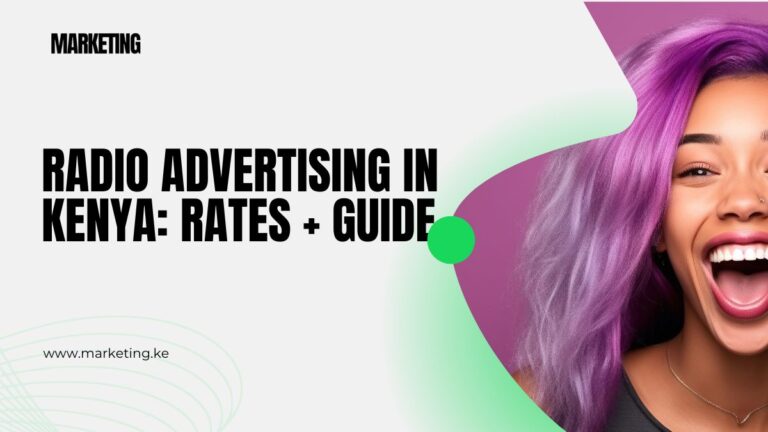TV Advertising in Kenya: Latest Rates + Guide
Last updated on July 9th, 2024 at 09:35 am
Overview of TV advertising in Kenya
TV advertising is an important and growing medium in Kenya. Over 90% of households in urban areas own a TV, making it an effective way to reach consumers across the country.
Major TV stations include Citizen TV, NTV, KTN, KBC, and local language stations.
TV ad spend has increased over 10% per year for the last 5 years, reaching almost KES 10 billion in 2019. Key factors driving growth include:
- Growing middle class with more disposable income
- Increase in local content production
- Launch of digital TV services
Advertisers like TV for its broad reach, visual format and prestige. Most common categories are mobile networks, FMCG brands, banks and real estate developers.
However, TV ads in Kenya can be expensive with rates ranging from KES 100,000-300,000 per 30 secs in primetime slots.
Overall, TV continues to be a powerful medium for brand building in Kenya that blends creativity and mass reach.
Trends in TV platforms
The TV landscape in Kenya is dynamic with new platforms and changing consumption patterns. Here are some of the key trends:
Rise of Digital TV
Prior to 2015, Kenya only had analog terrestrial TV services. The switchover to digital TV led by Signet signaled a new era. Digital TV platforms allow more channels and better quality reception. They include:
- Free-to-air – Stations like NTV, KTN and Citizen broadcast openly without encryption
- Pay TV – DStv, Zuku, StarTimes and GoTV offer subscription packages with local and international channels
- OTT streaming – Showmax, Netflix and Iflix provide on-demand programming over the internet
The rise of pay TV and streaming has increased options for viewers but also fragmented audiences. Advertisers must navigate multiple platforms to achieve reach.
Changes in Viewing Habits
As internet and smartphone penetration has risen, viewing habits have changed:
- More on-demand – Streaming platforms allow time-shifted viewing outside linear TV schedules
- Multi-tasking – Viewers increasingly use mobile phones and internet while watching TV
- Less appointments – Fewer people structure evenings around TV show schedules
This provides advertisers both opportunities through addressable ads and threats from shifting attention.
Interactive and Addressable Ads
Digital TV enables more interactive ad formats like branded menus, apps and games. I
t also allows advertisers to target viewers more granularly based on location, income and interests. Addressable TV ads are estimated to command 30-40% higher pricing from brands.
Other innovations include shoppable ads and dynamic ad insertion based on viewer data. These present promising pathways for advertisers.
Major TV stations and audience profiles
Below is an overview of major TV stations, channels and audience profiles for advertisers to consider:
Free-to-Air Channels in Kenya
Citizen TV
Citizen TV is the most watched station with national footprint and wide demographic appeal. Notable shows span news, Swahili soaps, sports, reality series and entertainment. Key audience stats:
- 12+ audience share of 64% in 2019
- 53% male, 47% female viewership
- Strong in 15-34 age bracket
NTV
NTV focuses on news, current affairs, Swahili/Nigerian entertainment and sports including Premier League football. Key audience stats:
- Strong following in urban areas
- Viewers tend to be higher income professionals
- Above average engagement on digital platforms
KTN
KTN is a popular station for local news and political coverage. Their audience skews slightly older than other national channels.
KBC
As the national broadcaster, KBC traffics mainly in vernacular programming and classic Kenyan content.
Local language stations like Inooro TV, Kameme TV and Ebru TV command loyal niches including political influence.
Pay TV/Streaming
DStv dominates pay TV commanding 80+% market share.
Key channels range from SuperSport, to news, movies, music, soaps, kids and African content.
Though household penetration is below 10%, it attracts higher income viewers.
StarTimes and Zuku offer cheaper alternatives beginning under KES 1,000 per month. Demand has risen sharply in counties and lower income areas. Streaming services like Showmax and Netflix remain niche due to internet costs though uptake rises steadily.
Competitive spending across media
How does spending on TV advertising compare to other major media in Kenya? Here is a breakdown of recent ad expenditure:
| Media | 2019 Ad Spend | Share |
|---|---|---|
| TV | KES 9.6B | 26.0% |
| Radio | KES 8.4B | 22.8% |
| Newspapers | KES 7.6B | 20.5% |
| Out of Home | KES 2.4B | 6.4% |
| Digital | KES 2.0B | 5.4% |
As seen above, TV represented over 1 in 4 advertising shillings in Kenya in 2019 making it the #1 media by spend. However, digital is rising rapidly from a small base as internet access grows.
Drilling down further:
TV Outlay
Nation Media Group stations (NTV) and Citizen TV split the lion’s share of TV ad revenues given their ratings and reach. Advertisers tend to use TV for brand awareness and emotional appeals to mass audiences rather than direct response. Common metrics include Gross Rating Points (GRP)s and Target Audience Ratings (TARPs). As one media buyer told me:
When done smartly, TV drives the conversation. The water cooler chatter after a good TV spot is invaluable and shows up in other media analytics down the line. The challenge is cutting through noise.
Radio Appeal
Radio offers national, regional and vernacular stations making flexible segmenation easy.
Most advertisers use radio as more of a “performance channel” to drive calls to action with precise demographic targeting and call out extensions.
Measuring listenership and outcomes is easier.
The audio format also suits background usage while working and commuting.
Classic 105, Radio Citizen, and Radio Jambo are among the top stations.
But vernacular stations also play a key role.
Newspapers Lagging
Print newspapers in Kenya face familiar challenges as digital alternatives take off.
Circulations for Daily Nation and The Standard have declined over 25% as smartphone news grows.
Most media buyers admitted newspapers now play second fiddle to online displays.
Though crucial for some niche B2B, employment and obituary advertising remains.
Digital Growth Trajectory
As internet access widens from 34% today to an expected 85% of Kenyans by 2025, digital channels commanding just 5% of ad spend are set to gain share.
Buying TV ads – process, metrics and optimization
For media buyers, efficiently planning, buying and optimizing TV advertising involves key steps:
Defining Campaign Objectives
Typical brand objectives for TV revolve around awareness, consideration, favorability and purchase intent.
Performance goals like site traffic, phone calls and sales conversions are harder to attribute.
Conducting pre-campaign brand lift surveys is vital for measurement.
Outline Target Audiences
Buyers profile target viewer segments including demographics, locations, viewing habits, interests and so on.
Granular categories span age, gender, income bands, households with kids, sports fans, news aficianados, language preferences and counties.
Citizen TV attracts mass Kenya-wide audiences while Showmax allows targeting of higher income urbanites. Such profiles inform channel selection.
Estimate Reach and Frequency
Using audience research panels and past data, buyers determine achievable TVRs (percentage of target viewers reached) for proposed budgets.
Normal parameters are 4-5+ reach over a 2-4 week campaign, requiring 3-6+ frequency for effective impact. Prime versus standard slot costs differ greatly.
Inputs spanning channel ratings, spot costs and target CPT/GRP are evaluated in tools like Primex to optimize plans.
Historical results give benchmarks.
Implementation and Stewardship
After booking slots via station sales teams and ad agencies, buyers steward campaign delivery pace.
They review weekly implementation and adjust to improve performance against KPIs like cost efficiency and audience delivery.
Common mid-flight changes channel mix, daypart rotation or budget shifts across weeks.
Measurement and Analytics
Campaign-end, buyers evaluate metrics like:
- Share of Voice: % of Category TV Impressions
- Target Reach: % Coverage of Audience
- View through attribution: Site Traffic From TV regions
- Brand Lift Surveys: Awareness and Consideration
Learnings improve future planning and budget allocation. Relative to other media.
TV Advertising Rates in Kenya
TV advertising rates in Kenya can be relatively expensive, but they offer a wide reach and excellent engagement for businesses seeking to target a large audience.
In this section, we will explore the costs and benefits of TV advertising in Kenya, as well as alternative advertising options.
Citizen TV advertising rates
Citizen TV advertising rates in Kenya are relatively affordable compared to other TV stations.
According to a source, you can advertise for as little as Kshs. 10,300 on Citizen TV, provided that the ad is five seconds or less.
This makes Citizen TV an attractive option for businesses looking to reach a large audience through television advertising.
For more detailed information on advertising rates, it is advisable to directly contact Citizen TV or their advertising sales representative at Royal Media Services.
Inooro TV advertising rates
The advertising rates for Inooro TV are as follows:
- Commercial Ads:
- 15 secs: 14,250 Kshs
- 30 secs: 25,200 Kshs
- 45 secs: 35,200 Kshs
- 60 secs: 44,000 Kshs.
- Spot ADs Cost:
- The cost varies based on the time of day:
- 7:00am – 9:30am
- 9:30am – 6:30pm
- 6:30pm – 8:30pm
- 8:30pm – 9:30pm.
For more information on advertising with Inooro TV, you can contact Royal Media Services via email at [email protected] or phone at +254 (0) 202721415.
NTV advertising rates
For the most accurate and up-to-date information on advertising rates for NTV Kenya, it is recommended to directly contact the advertising sales team at NTV Kenya.
This can usually be done through their official website or by reaching out to their advertising department via email or phone.
KTN advertising rates
The advertising rates for KTN are as follows:
- KTN Home:
- 15 secs: 14,250 Kshs
- 30 secs: 25,200 Kshs
- 45 secs: 35,200 Kshs
- 60 secs: 44,000 Kshs.
- KTN News:
- The rates vary based on the specific program and time slot. For example, the rates for KTN News range from 19,600 Kshs to 156,700 Kshs.
For more detailed information on advertising with KTN, it is advisable to directly contact their advertising sales team or refer to their official rate card for the most accurate and up-to-date rates.
Standard newspaper Kenya advertising rates
According to the available information, the advertising rates for Standard newspaper Kenya are as follows:
- Print Ads:
- The rates vary based on the size and placement of the ad. For example, the rates for a roadblock, overlay, sidekick, or peel ad are 200,000 Kshs for 12 hours and 400,000 Kshs for 24 hours.
- Digital Ads:
- The rates vary based on the type of ad and the platform. For example, the rates for a native banner article advert are 100,000 Kshs for a one-off placement, while the rates for a landing page for lead generation are based on a CPM rate of $2.5 to $3.
- The CPM rates for digital ads range from 1.4 to 3.0 USD per 1,000 impressions, depending on the platform and location.
HOPE TV Kenya advertising rates
The advertising rates for HOPE TV Kenya are available on the Hope Media website. The rates are subject to an additional 16% VAT and are effective from January 2017.
The rates vary based on the duration and time of the ad.
For example, the cost for a 30-second ad ranges from 25,000 to 40,000 Kenyan Shillings, depending on the time slot.
| Ad Duration | Time Slot | Cost (Ksh) |
|---|---|---|
| 30 seconds | 6am-12pm | 25,000 |
| 30 seconds | 12pm-6pm | 30,000 |
| 30 seconds | 6pm-12am | 40,000 |
Additionally, there are costs for other advertising services such as classified ads, presenter mentions, program sponsorships, and production services.
For specific details and to inquire about advertising with HOPE TV Kenya, you can visit the Hope Media website’s “Advertise” section.
Creative best practices for TV ads in Kenya
What makes for effective TV creative that motivates the desired viewer response? Though creative ideas must sync with campaign strategy, here are common best practices:
Quickly Grab Viewer Attention
TV has seconds to attract viewer eyeballs against surrounding clutter, noise and distraction.
Test openers show 70% tune out by 10 seconds if not intrigued. Strong hooks via questions, demonstrations, contrasts, movement, music and voices help cut through faster.
Communicate Core Idea Quickly and Clearly
30 second ads require disciplined editing to distill messages to one or two focal points.
Trying to cram too many complex details risks losing comprehension. Simplified messages focused on key consumer benefits or emotions have highest recall.
Blend Emotional Storytelling With Rationale
Leveraging feelings and experiences through storytelling, relationships and vignettes helps ads resonate besides stating functional claims or data.
But clear branding, framing the context and concise descriptions still enable message understanding.
Leverage Bold Visuals and Audio
TV’s motion, color and vibrance are ideal for dramatic, funny or inspiring demonstrations no other media can match.
Strong graphics, cinematography and music elevate experience beyond radio-style ads.
Short text overlays or scrips reinforce video’s impact.
Repetition and Consistent Branding
Given fragmented audiences, 3-4+ exposures are often needed for ad retention.
Brand logos, icons, colors, slogans and spokespeople cue recognition across exposures.
Campaigns with unified consistent identities have higher memorability.
Following such principles in storyboarding and creative optimization gives TV ads the highest probability of viewer engagement and response.
Radio advertising rates in Kenya
Radio advertising rates in Kenya are generally more affordable compared to TV advertising rates.
For instance, a 30-second spot during the morning drive time on Radio Maisha may cost around Ksh50,000.
Hope Media, a Kenyan radio station, offers commercial ads for 15 seconds at Ksh14,250, 30 seconds at Ksh25,200, 45 seconds at Ksh35,200, and 60 seconds at Ksh44,000.
Empire Group, a media company in Kenya, recommends the best radio stations for a business’s target audience and objectives within Kenya and helps with advertising on those stations.
KWETU Marketing Agency offers FM radio advertising in Kenya for businesses or brands due to their effect of being highly memorable and generating excellent consumer recall and a high call to action.
Alternative Advertising Options in Kenya
Compared to TV advertising, radio advertising in Kenya is more affordable.
A 30-second spot during the morning drive time on Radio Maisha, for example, may cost around Ksh50,000.
Print advertising in Kenya offers cost-effective options for businesses, with a full-page ad in the Daily Nation costing around Ksh100,000.
Online advertising is generally more affordable than traditional media advertising in Kenya, with a pay-per-click (PPC) ad on Google costing around Ksh50 per click.
Advertising in Matatus and Buses
If your brand targets the common citizen in Kenya, advertising in public matatus and buses is an effective way to reach them.
80% of working Kenyans with an income and thus purchasing use public matatus and buses to get to and from work.
This means that from Monday to Friday, you can easily talk to them about your brand by placing an advertisement on these vehicles.
Advantages and Disadvantages of TV Advertising in Kenya
TV advertising offers wide reach, excellent engagement, and highly specific targeting.
However, it can be difficult to analyze and track results, and the initial investment is high.
To get the most out of your TV advertising campaign, it is essential to create a well-designed ad that resonates with your target audience and effectively communicates your brand message.
TV advertising rates in Kenya can be expensive, but they offer a wide reach and excellent engagement for businesses seeking to target a large audience.
Alternative advertising options, such as radio, print, online, and matatus and buses, can be more cost-effective but may not offer the same level of reach and engagement as TV advertising.
Ultimately, the choice of advertising medium depends on your business goals, target audience, and budget.
Key Takeaways
TV advertising maintains major competitive advantages in Kenya given broad penetration, visual storytelling ability and prestige. As the #1 media channel by ad spend, it drives both mass reach and culture.
However, consumption patterns and segmentation are evolving across free-to-air, pay TV and streaming options. Similarly a range of ad formats beyond classic 30 second spots are emerging.
As metrics and addressability improve, buyers can better attribute TV’s impact across the purchase funnel from awareness down to sales.
But creativity anchored on strong human insights remains the ultimate driver of attention, recall and action.
Read also:








Love the indepth information. Thank you for keeping us updated.